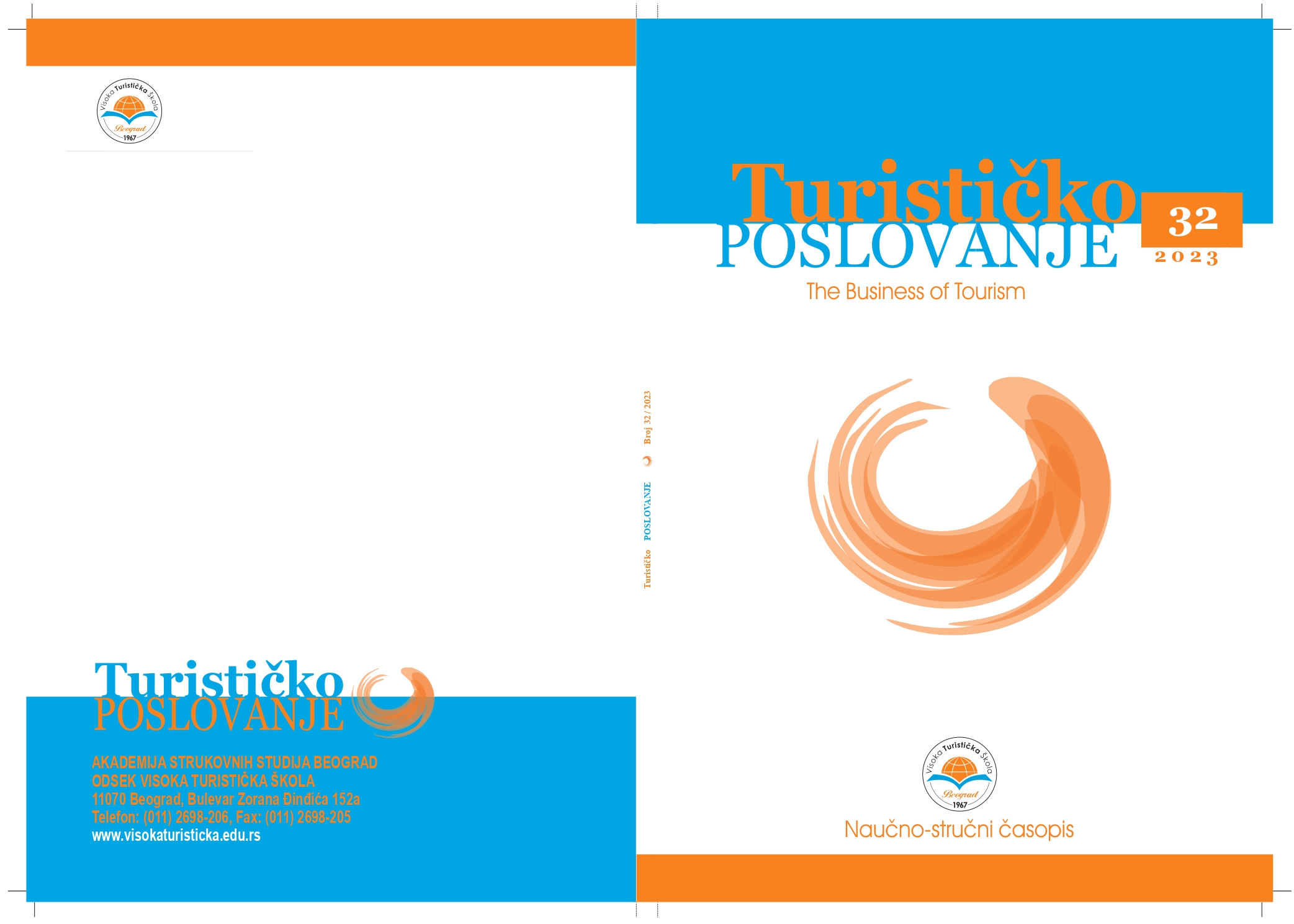PERSPECTIVES OF THE DEVELOPMENT OF DARK TOURISM AT THE SITES OF GENOCIDE IN BELGRADE
Abstract
Abstract: Dark tourism, or visits to places marked by death, violence and suffering, is an increasingly important component of the modern tourist experience. Genocide sites, which are witnesses of historical atrocities and tragedies, offer great tourist potential in Belgrade. This paper analyzes the perspectives of the development of dark tourism in such places in Belgrade. Through the analysis of cultural, sociological and economic aspects, the work examines the possibilities of integrating dark tourism into the existing tourist offer, with a special focus on preserving the authenticity of these locations and educating visitors and local residents about historical events and the moral implications of the visit. The paper also discusses the challenges and opportunities for raising awareness about the importance of remembering the victims and promoting sustainable tourism at the genocide sites in Belgrade. Through this analysis, the paper identifies the significant tourism potential of dark tourism in Belgrade and calls for the planned development and preservation of these locations in order to enable visits, education and honoring of the victims, which would contribute to the local and global understanding of historical events.
References
Bajford, J. (2011). Staro Sajmište – mesto sećanja, zaborava i sporenja, Beogradski centar za ljudska prava, Beograd.
Collins-Kreiner, N. (2016). Dark tourism as/is pilgrimage. Current Issues in Tourism, 19:12, pp.1185-1189. https://doi.org/10.1080/13683500.2015.1078299
Dimitrovski, D., Milićević, S. i Lakićević, M. (2021). Specifični oblici turizma. Univerzitet u Kragujevcu, Fakultet za hotelijerstvo i turizam u Vrnjačkoj Banji.
Kesar, O. (2014). Obilježje i dosezi razvoja memorijalnog turizma u Hrvatskoj. Liburna, Vol. 3/No. 1, Zadar, str. 50-79.
Macura-Vuksanović, Z. (2012). Život na ivici - stanovanje sirotinje u Beogradu 1919-1941. Orionart, Beograd.
Manić, M. (2018). Marketinški pristup specifičnim oblicima turizma u kontekstu revitalizacije nerazvijenih oblasti istočne Srbije. Marketing, 49(4), str. 299-310. https://doi.org/10.5937/markt1804299M
Nikolić, J. (2017): Logor Banjica, 1941-1944 – zatočenici iz Požarevca i Braničevskog okruga. Edicija “Izložbeni katalozi” Katalog 23, Istorijski arhiv Požarevac, str. 5-7.
Njegovan, A., i Bagarić, L. (2020). Potencijal mračnog turizma kao turističkog proizvoda destinacije. Zbornik radova Ekonomskog fakulteta Sveučilišta u Mostaru, (26), str. 9-28.
Ozimić, N. (2011): Logor na Crvenom krstu. Narodni muzej Niš, Niš.
Rabotić, B. (2011c). Mračni turizam u teoriji i praksi. Hotel Link 17/18, str. 35-48.
Rabotić, B. (2013). Selektivni oblici turizma. Visoka turistička škola, Beograd.
Radle, R., i Pisari, M. (2013). Mesta stradanja i antifašističke borbe u Beogradu 1941 – 1944. Priručnik za čitanje grada, Forum za primenjenu istoriju, Beograd.
Ristanović, R. (2021). Logor na Sajmištu – svedočenja dvojice zatočenika, Muzej žrtava genocida, Beograd.
Šerić, N. (2017). Usporedba stanja i mogućnosti mračnog turizma u Hrvatskoj i svetu. Završni rad, Univerzitet u Splitu, Sveučilište u Splitu, Ekonomski fakultet, Split.
Slavić, S. (2022). Disonanca kao koncept očuvanja graditeljskog nasleđa: studija slučaja Beogradskog sajmišta. Arhitektura i urbanizam, br. 54. str. 69-86.
Stone, P. (2010). Death, dying and dark tourism in contemporary society: A theoretical and empirical analysis (Doctoral dissertation, University of Central Lancashire).
Tarlow, P. (2005). Dark Tourism: The Appealing ‘Dark’Side of Tourism and More. In, M. Novelli, ed. Niche Tourism: Contemporary Issues, Trends and Cases, pp. 47–57. Oxford: Elsevier Butterworth-Heinemann.
Totić, M. (2022). Evropa i govor mržnje – nenaučne lekcije iz prošlosti. Naučna konferencija sa međunarodnim učešćem, Stradanje Srba, Jevreja, Roma i ostalih na teritoriji bivše Jugoslavije, Beograd, br. 9. Fakultet za poslovne studije; Fakultet za strateški i operativni menadžment Univerziteta Union Nikola Tesla.
Willis, E. (2014). Theatricality, Dark Tourism and Ethical Spectatorship. Palgrave Macmillan London, pp.18. https://doi.org/10.1057/9781137322654
Žarković, N. (2009). Prolazni logor Topovske Šupe. Nasleđe br. 10, Zavod za zaštitu spomenika kulture grada Beograda.
Živković, N. (2018). Banjički logor. Zavod za zaštitu spomenika kulture grada Beograda, Beograd.
http://www.protivzaborava.com/wallpaper/logor-u-milisicevoj-ciglani/
https://beogradskonasledje.rs/aktuelnosti/pocetak-radova-na-centralnoj-kuli-u-okviru-spomenika-kulture-staro-sajmiste
https://beogradskonasledje.rs/kd/zavod/vozdovac/banjicki_logor.html
https://memorijalnicentar.rs/
https://sacuvajmozelenuzvezdaru.org/2022/04/09/kad-su-ciglane-bile-glavne-na-zvezdari/
https://turistickaprizma.rs/mracni-turizam-najpoznatiji-lokaliteti-u-srbiji/
https://visitnis.org/sta-videti/atrakcije-i-muzeji/cele-kula/
https://www.2.muzejgenocida.rs/o-nama
https://www.dark-tourism.com/index.php/serbia
https://www.gradnja.rs/beograd-staro-sajmiste-centralna-kula-rekonstrukcija/

